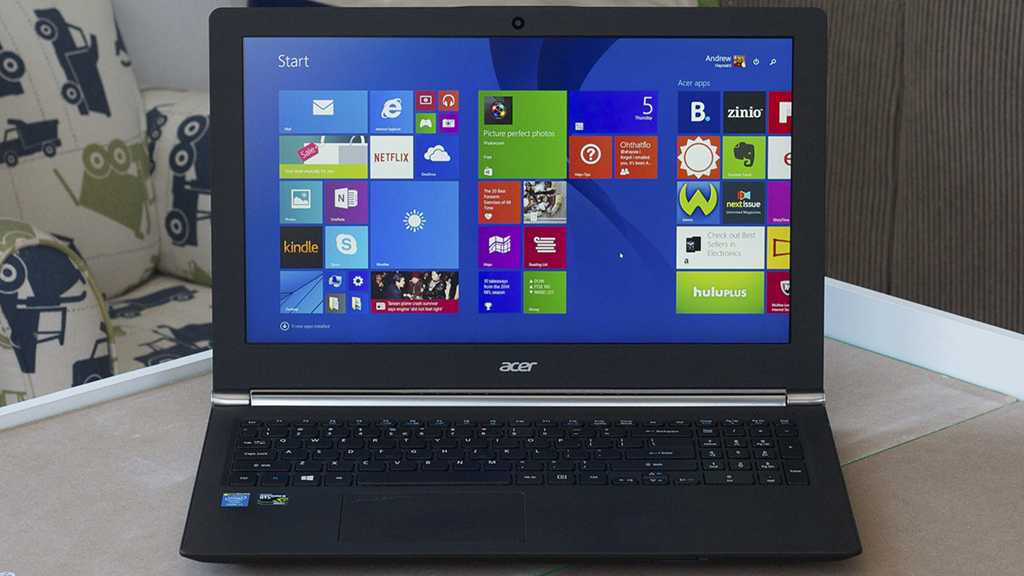Why you can trust TechRadar
The V15 Nitro has a thin construction for a gaming notebook, considering all of the power found within. It has some heft, coming in at 5.29 pounds, and has a wide frame to accommodate its 15.6-inch display, measuring 15.3 x 10.1 x 0.9 inches. It has the exact same weight as the Lenovo Y50, as well as very similar dimensions. Both the Acer and Lenovo laptops are slimmer and lighter than the Asus GL551, due its optical drive.
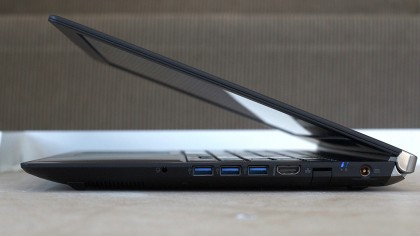
Here is the Acer V15 Nitro Black Edition configuration given to TechRadar for review:
Spec Sheet
- CPU: 2.5GHz Intel Core i7-4710HQ (quad-core, 6MB cache)
- Graphics: NVIDIA GeForce GTX 860M (2GB GDDR5 RAM), Intel HD Graphics 4600
- RAM: 8GB DDR3L
- Screen: 15.6-inch, 1,920 x 1,080 TFT Color LCD
- Storage: 1TB HDD (5,400 RPM)
- Ports: 3 x USB 3.0 ports, HDMI, Headphone jack, Ethernet, SD Card reader
- Connectivity: Dual Wireless Antennas, Acer Nplify 802.11a/b/g/n, Bluetooth 4.0
- Camera: 720p webcam
- Weight: 5.29 pounds
- Size: 15.3 x 10.1 x 0.9 inches
What you see above is the entry-level, VN7-591G-74LK model available in the US,currently listed for $1,029 (about £672, AU$2,199). You can also get an upgraded version - the VN7-591G-70TG - with a 4K (3,840 x 2,160) display, 16GB RAM, and a 256GB SSD that augments the existing 1TB HDD. It's a huge step up in build, but also a noticeable bump in price: it's listed at $1,499 (about £983, AU$2,999) on NewEgg.
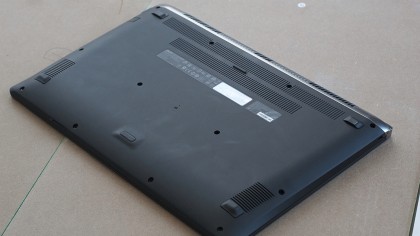
You won't find a comparable model available from UK shops. However, there is a single VN7-591G option that switches up some of the specs: it appears to have a 2.9Ghz Intel Core i5-4210H dual-core processor with a bump up to 12GB RAM. That laptop sells for £899 (about $1,373, AU$1,760). A version of this laptop also does not seem to be available for the Australian market.
In some respects, with the model we reviewed, it seems like you get a little bit less bang for your buck with the Acer V15 Nitro compared to its aforementioned rivals. For example, for $999 (about £657, AU$1279), you get twice the RAM on the Asus GL551, not to mention a DVD drive - although that could be an unwanted addition for some.
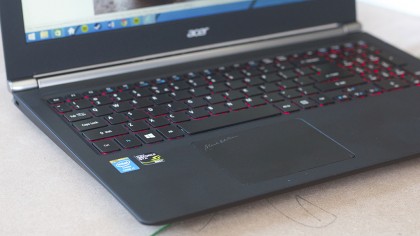
And when it comes to the $1,000 (£999, AU$2,199) Lenovo Y50, you again get double the RAM, as well as an 8GB SSD cache in the 1TB HDD, although that laptop has a slightly weaker processor. But what really matters, of course, is how the device works as a whole.
Performance
With the Nvidia GTX 860M within, the Acer V15 Nitro is equipped to handle modern games at high - although typically not maximum - settings with a playable frame rate. Running at ultra settings, BioShock Infinite's frame rate suffered, dipping well enough below 60 frames per second to diminish the fun. But sacrificing a negligible amount of texture detail and dropping down to high settings resulted in a smooth, beautiful experience.
Switching over to newer games like Far Cry 4 and Dying Light, the performance at high settings was consistent most of the time, but frame rate dips and occasional momentary freeze-ups were more common.
Here's how the Acer V15 Nitro fared in our benchmark tests:
Benchmarks
- 3DMark: Ice Storm: 105,529; Cloud Gate: 16,069; Fire Strike: 3,733
- Cinebench Graphics: 85.08 fps, CPU: 632 points
- PCMark 8 (Home Test): 2,826
- PCMark 8 Battery Life: 1 hour and 48 minutes
- BioShock Infinite (1080p, Ultra): 41 fps; (1080p, Low): 126 fps
- Metro: Last Light (1080p, Ultra): 16 fps; (1080p, Low): 61 fps
Put through our lineup of benchmark tests, the results more or less showed what we expected: the laptop can handle games and other tasks with great skill most of the time, but you'll need to lower settings or uncheck optional perks to maintain consistent performance in some cases.
That's especially evident with Metro: Last Light, which has a habit of showing gaming laptops in their weakest moments. Here, with every setting maxed out, I saw an average frame rate of just 16 fps. Amazingly, that's an improvement over both the Asus GL551, which averaged less than 12 fps, and the Lenovo Y50, which didn't even hit double digits with its average frame rate.
In terms of the 3DMark tests, the V15 Nitro handily beat the Lenovo with all three scores (and by a wide margin in two cases), while the Asus is a lot more comparable with smaller deviances between the figures. Of course, the Lenovo laptop has a weaker processor than the Acer and Asus models, and that came through very clearly in the testing.
The drain game
If there's one stat in the benchmarks listing that's frankly stunning - and not in a good way - it's the battery life result. Indeed, our test generated results of just 1 hour and 48 minutes, and while gaming laptops are generally understood to sacrifice battery life in favor of performance, that's dismal even by those standards.
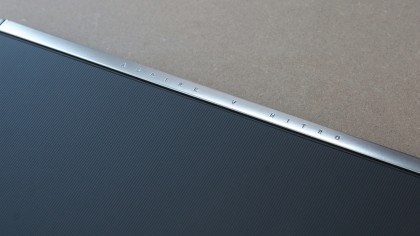
By comparison, the Asus gave us 2 hours and 23 minutes, while the Lenovo lasted a full hour longer, at 2 hours and 49 minutes. Granted, the benchmark tests push the computer harder and more consistently than you will during typical use, but this is still a meager battery. With streaming video or a mix of web browsing and word processing, the battery typically topped out at just less than 3 hours.
Whatever the case, the result is the same: this isn't a machine designed for extensive use away from a wall charger, and the battery life proves the biggest weakness with Acer's V15 Nitro. It's just not built for the long haul.
I can't see clearly now
I also had an inconsistent experience with the 15.6-inch 1080p display included on the Acer V15 Nitro. On one hand, it is a very high-resolution screen, and certain games look downright amazing on it - particularly the gorgeous art direction of BioShock Infinite.

But those were the rare, ideal moments. Elsewhere, I struggled to find a consistently great viewing angle that gave full illumination of the screen. From an angled view, the display loses some clarity and contrast - so it's definitely not the best pick for a screen to share with someone else nearby. The matte finish also seems to wash out the image just slightly, and I could never get the screen to be as bright as I wanted. It's not a terrible display at all, but it can be finicky.
Inversely, I was really impressed by the speakers on the V15 Nitro. The four speakers found on the bottom of the device deliver clear, quality sound that even has a decent (but still light) touch of bass. It exceeded my expectations for music and video playback alike from a laptop.
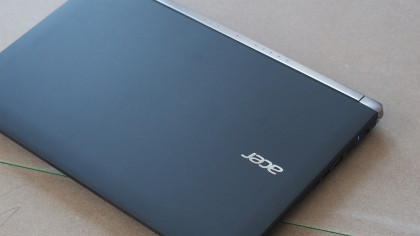
Bundled software
The Aspire V15 Nitro is unfortunately very heavy on third-party software, the majority of which can be considered bloatware. You'll find a number of apps that aren't standard on Windows, and many that users probably won't want or need - but you can remove them manually if you don't want them clogging up your menus and hard drive. Here are a few examples:
- Booking.com – The travel website has its own dedicated app preinstalled on the Aspire V15. That seems really unnecessary.
- Next Issue – This app allows access to more than 100 digital magazines (like Sports Illustrated and Esquire) for one monthly fee. It's useful, but niche.
- McAfee LiveSafe – Internet security software that comes bundled with the V15 Nitro, but Windows has its own built-in Windows Defender, and McAfee will keep bugging you to register. It's annoying.
- WildTangent Games – It's not a collection of free games, but rather a storefront that directs you towards games you can buy. That's disappointing.
- Acer Portal – You'll see a number of Acer apps like "abDocs" and "abFiles" - they're all part of Acer's "Build Your Own Cloud" initiative, which lets you access local files from other devices. The portal acts like a hub for all of that.
